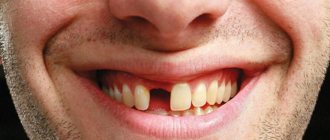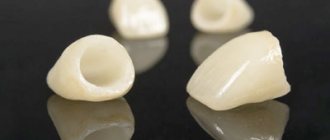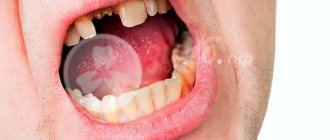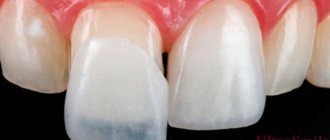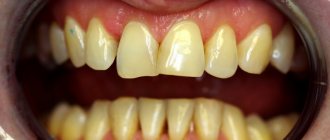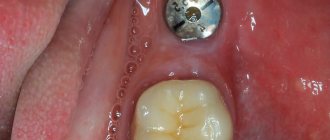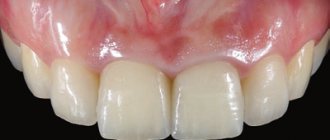Causes of dental defects
Lengthening or shortening of one of the incisors is usually a congenital anomaly. This feature of dentition development is associated with genetic factors. Experts also include the following as possible causes of the problem:
- periodontitis,
- malocclusion,
- presence of supernumerary teeth,
- abnormal shape of the alveolar process,
- disruption of the process of resorption of the roots of baby teeth.
Changes in the length of the central incisor can also be a consequence of jaw trauma. If a tooth is mechanically damaged, its lower part may chip. Because of this, the appearance of the smile deteriorates, discomfort occurs when chewing, and the risk of developing various diseases increases.
Why does thorotoanomaly occur?
Most often, the tooth is forced to take a pathological position due to lack of space in the jawbone due to macrodentia (large teeth in relation to the bone) or an excessively narrow jaw. In this case, it tends to turn around so as to take up as little space as possible, and the minimum will be achieved when turning at an angle of 45°. But pathology arises not only due to the primary lack of free space.
- The crown can rotate in the socket due to constant pressure exerted on it from the side or below, either by a supernumerary tooth, or by complete “neighbors” that erupt not entirely physiologically - for example, with a delay.
- Quite often, erupting permanent teeth unfold due to the persistence of the milk teeth that precede them. If during the period when baby teeth fall out, the “old” one is in no hurry to fall out, then the “new” molar will have to bypass the obstacle, deviating to the side or turning around the vertical. Pathology can be avoided by timely removal of worn-out milk teeth.
- Sometimes the cause of non-physiological tooth eruption is a dental follicle that is incorrectly formed during pregnancy or in early infancy.
- Often a permanent tooth rotates as a result of a mechanical injury received by a child at the stage of changing the primary bite to a permanent one.
Possible consequences
Dental defects must be corrected in a timely manner. On chipped teeth, the enamel becomes thinner, so they quickly turn yellow and soon acquire a brown tint. In addition, the cracks are filled with plaque, which mineralizes and becomes a favorable environment for the growth of bacteria. Because of this, the risk of developing caries, pulpitis, gingivitis and periodontitis increases.
Congenital dental anomalies also lead to various problems. Let's list the main ones:
- speech dysfunction,
- formation of mouth breathing,
- uneven distribution of chewing load,
- development of gastrointestinal tract diseases.
To avoid serious health problems and maintain the integrity of the dentition, it is necessary to correct uneven incisors.
Elimination methods
Methods for correcting malposition will depend on the degree of deviation in tooth height. Correction of supraocclusion with a slight deviation in height is carried out by grinding the surface of the cutting and chewing parts.
A slight deviation in height during infraocclusion can be corrected with crowns or ceramic onlays.
In the case of a complex anomaly, they resort to hardware treatment, the options of which will depend on the age of the patient and the cause of the deviation.
The low position is corrected using devices that extend the teeth simultaneously with the alveolar ridge.
For this purpose, classic orthodontic plates are used, equipped with an elastic rod, screws, springs and other additional devices that enhance the effect of the device.
High position is corrected through the use of mouthguards, inclined plates and braces.
The treatment method will, first of all, be selected based on the patient’s age. So, for children with primary and mixed dentition, more gentle options are used than for correcting anomalies with a permanent dentition.
Let's find out what impacted teeth are and how the pathology is eliminated.
In this publication we will talk about the reasons for the development of awl-shaped teeth.
Follow the link https://orto-info.ru/zubocheliustnye-anomalii/zubov/polozheniya/tremyi.html to learn more about gaps between teeth.
In children
To correct the height of teeth in childhood, removable appliances are most often used. In case of low position of single teeth, such a device is an orthodontic plate made of plastic, with a built-in vestibular metal arch located at the level of the cutting part of the teeth.
The arm of the device is curved in such a way that it exerts constant pressure only on the problem area in the area of the alveolar process. In addition to the bow, the device has a ring that is fixed on the abnormal organ.
A special hook is soldered onto the ring, designed to fix the vestibular arch. While wearing the device, the arc is thrown with force over the hook, creating force in the vertical direction.
To treat supraocclusion in childhood, they resort to the method of rebuilding the alveolar process of the problem area, due to the influence of a plate with a bite pad or special plastic overlays.
In order to ensure constant pressure on the pads and platform, light-curing plastic is periodically applied to them, which is then ground to the required height.
Treatment of anomalies in the position of tooth height in mixed dentition takes from 2 months to 1.5 years, depending on the severity of the anomaly.
For information on correcting the shape and position of teeth in the anterior part of the lower jaw, see the video.
In adults
In adults, as well as in children, intermaxillary traction is used to eliminate infraocclusion. Only in this case, non-removable devices are used, equipped with a rubber rod and wire ligatures.
This device consists of four support rings, two of which are fixed on the upper jaw and two on the lower teeth. On each ring, hooks are soldered on the vestibular side, on which an elastic rod is fixed.
Due to its influence, dentoalveolar elongation occurs. To enhance the effect, special beams with notches are soldered to the rings in a horizontal position to secure a wire ligature or additional elastic traction.
To achieve the effect, it may take from 6 months to 2 years, after which this device can be used as a retention option. It must be worn for at least 2 hours a day with the most minimal tension.
To eliminate supraocclusion, a complex technique is used using braces and orthodontic aligners. Combined use will allow the formation of a new shape of the alveolar bed and the correct position of the tooth.
The combination of methods significantly shortens the treatment period, the average duration of which is 1 year.
When should you see a doctor?
Dentist help is necessary if one of the incisors is in a high or low position. In children, this defect can disappear without any intervention when replacing milk teeth with molars. If different lengths of the front teeth persist despite a fully formed bite, you should consult a doctor.
You should also contact a specialist:
- when the enamel darkens,
- increased sensitivity of teeth,
- acute toothache,
- cutter mobility,
- formation of a sharp cutting edge.
The dentist will conduct an examination, determine the cause of the problem and help solve the problem.
Possibilities of teeth extension
Using one of the methods of teeth extension, it is possible to change their size and shape. Thanks to extensions, the dentist is able to make teeth longer and wider. By lengthening your front teeth by 1–3 mm, you can get an amazing result - the updated smile area will make you look younger overall. Also, extensions will save the beauty of the front part of the teeth in case of injury, when single chips occur. In this case, the tooth is restored to its normal size and is no different in appearance from its neighbors. Among other things, with the help of extensions you can not only lengthen your teeth, but also make them wider to eliminate unattractive gaps in the dentition.
Methods for correcting front teeth of different lengths
Discrepancy in the coronal height of the central incisors can be corrected in several ways.
- Filling. Photopolymer restoration is the most affordable method of restoring the optimal length of teeth. Using composite material, you can build up the missing part of the crown.
- Wearing braces. Orthodontic treatment allows you to eliminate various defects in the dentition, including shortening and lengthening of one of the incisors.
- Installation of veneers. Ceramic or porcelain onlays replace the outer layer of teeth and provide the desired length. You can choose plates of a natural shade or snow-white.
When choosing an appropriate correction method, it is necessary to take into account the degree of deviation of the tooth height from the norm and the characteristics of the bite.
Treatment methods
The treatment method for this pathology is selected based on the cause that caused it. If the teeth and gums are in good condition, then it will be enough to perform gum surgery or install veneers, which will lengthen the crown part. If inflammation is present, then the treatment tactics should be identical to the methods for solving the problem of periodontitis. In any case, a visual examination, diagnosis of the condition of teeth and gums, followed by the development of an individual rehabilitation plan will be required.
Trimming the labial frenulum The labial frenulum is usually very short, which results in exposed teeth. But in a number of situations, on the contrary, it can be excessively long and literally hangs over the crowns. In such a situation, the size of the crowns naturally becomes smaller. Plastic surgery of the frenulum will solve the problem - this involves cutting off part of the mucous membrane and suturing it. The procedure can be performed at almost any age. Local anesthesia is required.
Price:
5000 rubles more about the solution
Gumplasty The doctor visually lengthens the teeth by trimming the gums and changing the position of the gingival contour. The operation is only permissible on healthy gums and teeth. At the same time, it may be necessary to carry out a remineralization procedure, since the part of the teeth that is located under the gums is more susceptible to external mechanical influences. If a large volume of mucous membrane was trimmed, additional microprosthetics will be required using veneers or lumineers.
Price:
from 6,000 rubles more about the solution
Veneers and lumineers Thin onlays allow you to correct many aesthetic defects in the dentition. Microprostheses are created from ceramic composite, ceramics or zirconium dioxide. If you have short teeth, they allow you to change their height, but only in the front part of the row, since they will simply break off on the lateral chewing elements. Prosthetics are often combined with gingival contour plastic surgery.
Price:
from 15,000 rubles more about the solution
